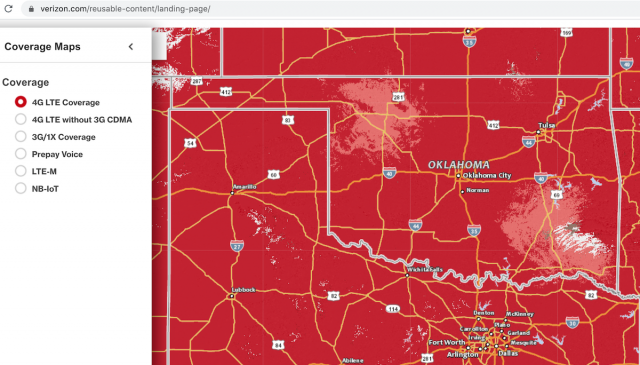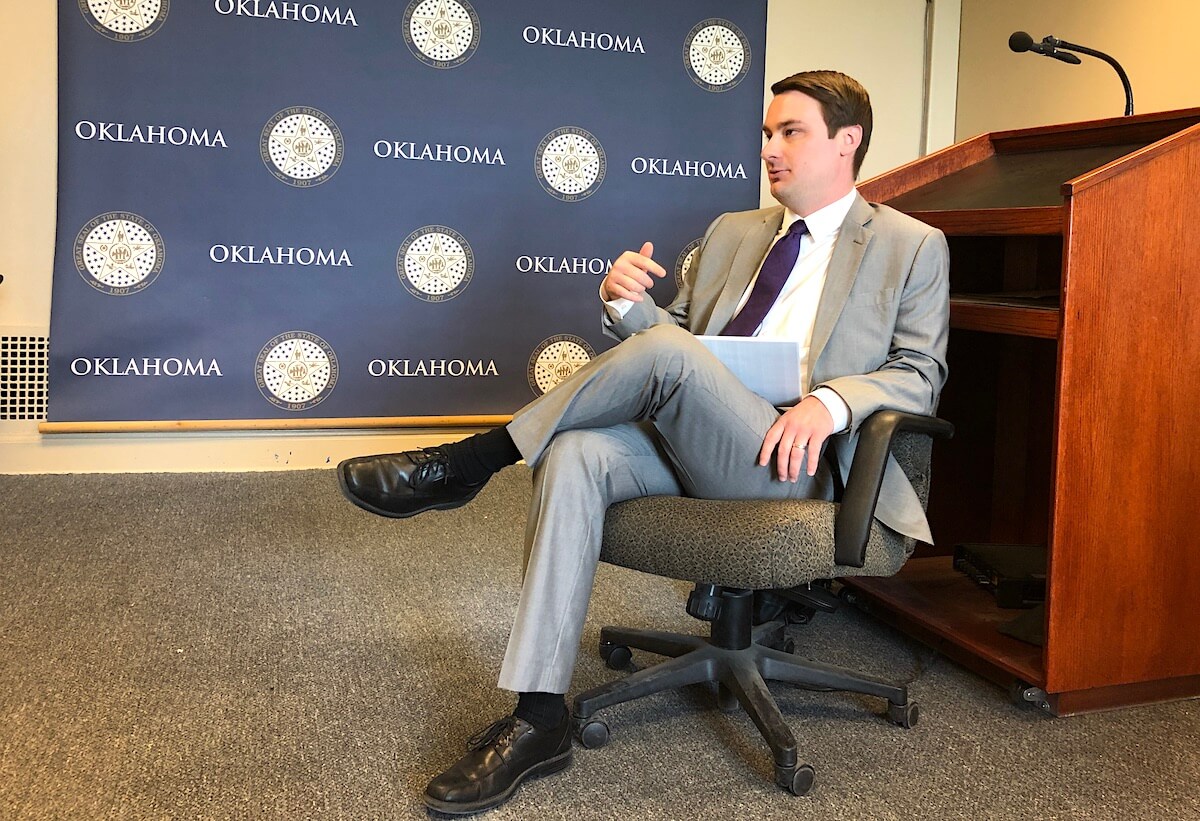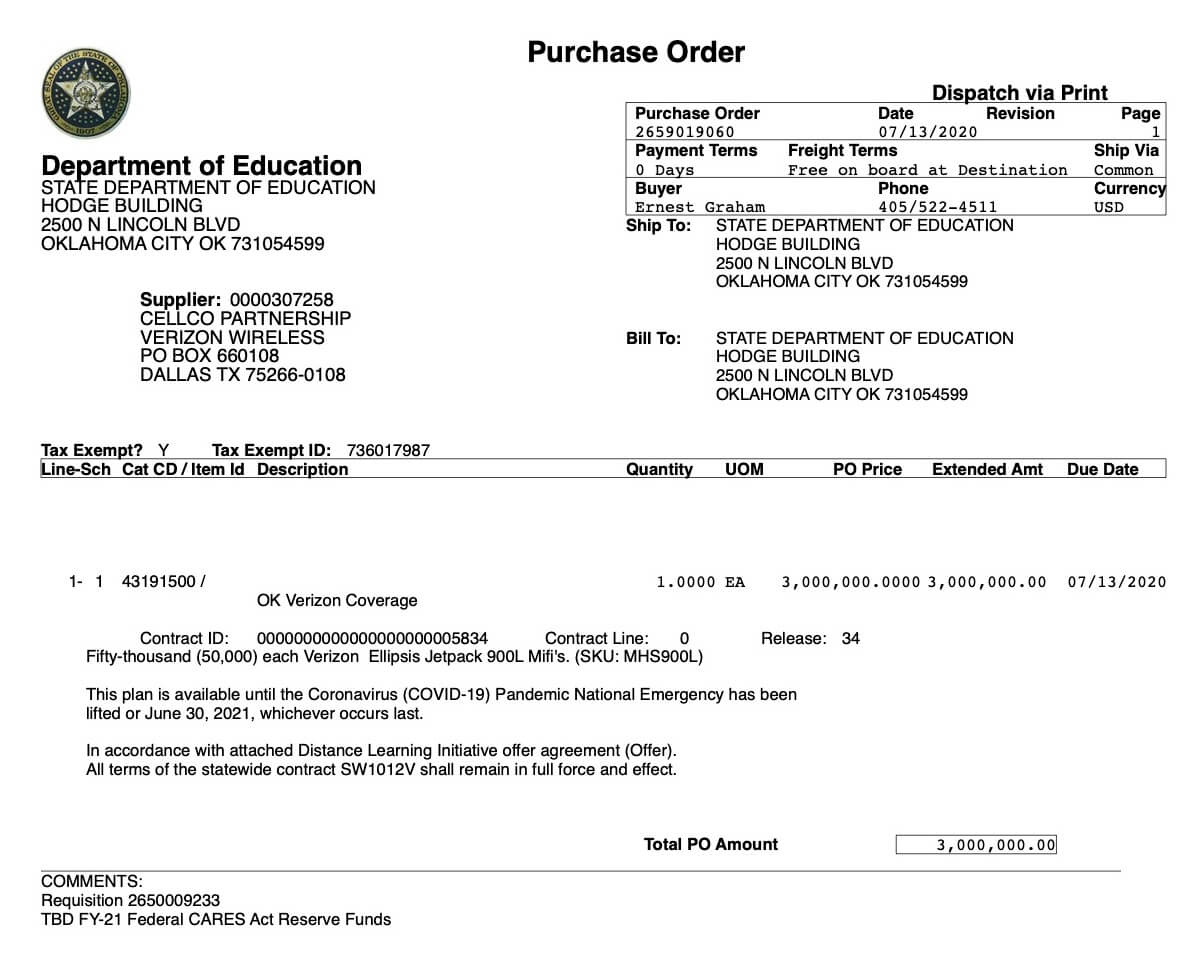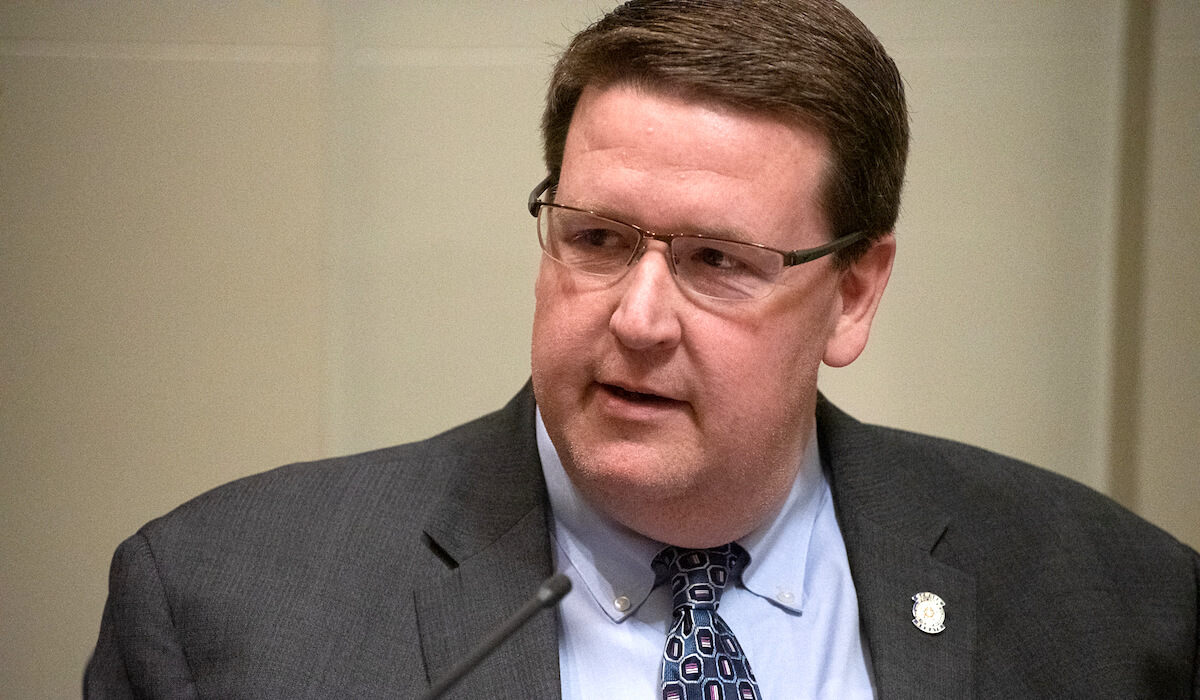
In preparation for an unprecedented school year likely to feature more distance learning than ever before, Oklahoma Gov. Kevin Stitt and Oklahoma Superintendent of Public Instruction Joy Hofmeister are allocating millions of dollars from the CARES Act to improve access to online curriculum and to the internet itself.
But because Congress sent the discretionary portions of Oklahoma’s federal funding to Stitt and Hofmeister’s offices, their decisions on which private companies are receiving lucrative contracts have been made largely behind the scenes, without a competitive bidding process and in an effort to race the school bell that will start the academic year.
Complicating transparency issues further are the continued limitations of CARES Act reporting on the Oklahoma Checkbook website, which is supposed to track the entire $1.26 billion of CARES Act funding designated for Oklahoma state government. While the Legislature passed SB 1944 in May to require the publication of “daily reports of all expenditures” of CARES Act funds, the website features no description about a handful of Oklahoma State Department of Education entries totaling about $13.2 million. The site also does not distinguish between money sent to agencies for programmatic spending, money repaid to agencies as reimbursement or money designated through Stitt’s discretion.
“I presented that bill on the floor, and I reached out to the executive branch about a month ago with this concern and they agreed that it was an issue. The current provider they use requires manual entry for all of the data on the site,” said Rep. Kyle Hilbert (R-Depew). “I just called and double-checked with the administration on this to make sure it is accurate, and they informed me that there will be a more robust site going live within the next couple of weeks.”
‘All of these COVID dollars are taxpayer dollars’

Meanwhile, two multi-million-dollar education contracts have been announced in the past week alone: a $3 million purchase of 50,000 Verizon mifi mobile hotspot devices and a more than $11 million commitment to Edmentum, a Minnesota company that specializes in digital curriculum. Neither contract involved a public bid process because each company already had state contracts, which triggered an exemption in the Oklahoma Competitive Bidding Act.
While state leaders have praised both the Verizon agreement and the Edmentum deal, others have concerns about the large amounts of public money being dispatched at light speed with limited oversight, a hallmark of the federal CARES Act.
“All of these COVID dollars are taxpayer dollars, and I want to make sure they are spent in the most responsible way possible,” said Rep. Marcus McEntire (R-Duncan). “Bidding processes shouldn’t be scuttled. I realize there are some time constraints and they have to move fast because this stuff is being thrown at us really quickly, but we can’t just jettison the best practices to get it done.”
McEntire serves on the 23-member bipartisan “legislative advisory group” Stitt announced May 12, the same day he signed SB 1944. The group typically meets every two weeks, and legislators have varying opinions about how “advisory” their roles actually are.
“I do feel like they are taking input from us, and I’ve seen where we’ve made suggestions and they’ve implemented those,” said Hilbert, another member of the committee. “I’m sure if you talk to every legislator on there, they’re all going to have a different opinion. But I do think [the governor’s team is] making a legitimate effort.”
Hilbert serves as vice chairman of the House Appropriations and Budget Committee and is heavily involved in the Legislature’s annual budget discussions. Even though the Legislature has no direct role in spending it, Hilbert has tracked CARES Act funding for the past three months and can explain the nuances of the various pots of money: $1.2 billion for state and local government reimbursements; $40 million for the Governor’s Emergency Education Relief (GEER) Fund; $15.3 million for Hofmeister’s education fund; $47 million for Oklahoma County; $114 million for Tulsa County; and $114 million for Oklahoma City.
“The big pot of money — the $1.2 billion — is kind of frustrating. They put so many shackles on it,” Hilbert said of Congress. “I don’t know what other states are looking like, but in Oklahoma we didn’t really need another dime for our state, we really just needed extra flexibility to be able to use the money they sent us.”
Hilbert said the $1.2 billion in reimbursement funds has been the “main focus” of the biweekly meetings, and he pointed to Stitt’s designation of $100 million for the Oklahoma Department of Commerce’s Business Relief Program as a notable CARES Act situation.
“You really have more flexibility in how you spend it to boost up the private sector than you do in how you spend it for the public sector,” Hilbert said. “You really do have a lot of flexibility for economic stimulus that you don’t have in terms of how you spend it on the public side, which is just interesting.”
Edmentum could offer expanded curriculum even after pandemic

One company benefiting from CARES Act dollars in the private sector is Edmentum, which was selected by the Stitt administration to provide digital curriculum statewide for grades 6 through 12 as part of the governor’s Learn Anywhere OK initiative. The Oklahoma Supplemental Online Course Program, which is a partnership between the OSDE and the Statewide Virtual Charter School Board, will receive the $12 million for the program. About $6.8 million of that will go to Edmentum for statewide access to the middle and high school online curricula, and another $5 million will go to school districts and public charter schools in chunks ranging between $5,000 and $20,000 per district or charter.
“Schools will be able to purchase elementary (K-5) content in social studies and/or science for $50/subject/student,” Secretary of State and Secretary of Education Michael Rogers said in an email explaining the $5 million allocation. “Additionally, schools can purchase digital courses with a teacher of record. This will allow schools to offer advanced coursework, typically unavailable in rural areas.”
The Oklahoma Public Schools Resource Center has also received about $200,000 to provide technical, curriculum and professional development support for schools using Edmentum. Brent Bushey, the OPSRC’s executive director, said statewide access to online-instruction curriculum should present a valuable “mindset change” for Oklahoma’s education system regardless of how long the pandemic lasts.
“Before the shutdown, in most rural areas of the state, advanced coursework like foreign languages are very rare because the traditional model of a teacher requires so many students, and that’s not typically possible in rural areas for advanced courses,” Bushey said. “Learn Anywhere OK allows that issue to be addressed in the short-run, and ideally that will continue to be addressed after the pandemic.”
While Stitt’s funding for the Edmentum program will offer schools the chance to conduct more online instruction than ever before, the governor has emphasized his believe that schools need to be open if possible for in-person classes. Last week, he held a press conference to announce $10 million in CARES Act funding for personal protective equipment at public and private schools.
“Schools are an essential part of our society,” Stitt said July 30. “It is critically important that they operate safely and effectively for all students. Our kids cannot miss another year of school.”
For local districts that are already delaying or canceling in-person classes for the fall semester, many will likely use Edmentum curricula in an attempt to keep students learning from home.
“Edmentum is a proven provider of digital curriculum and assessment services to Oklahomans. Edmentum is the oldest digital instruction provider and has delivered blended learning options to educators and students for over 60 years in a wide variety of classroom settings,” Rogers said. “We also wanted to provide Oklahoma schools a comprehensive platform that delivers direct instruction, accessible to all K-12 learners. The Oklahoma State Department of Education is providing access to Exact Path for the 2020-21 school year. The wide variety of subject areas and Edmentum programs that are being offered through Learn Anywhere OK are complementary to the work being done by the OSDE.”
Asked whether there was a bidding process for selecting a curriculum provider for Learn Anywhere OK, Rogers said there was not.
“This was a sole-source contract directly with Edmentum,” Rogers said. “This was in part because of the governor’s emergency declaration, using the GEER Funds and the timeliness of turning around a product quickly.”
Verizon hotspot contract contains clause that could boost cost

If time is money, then money is time, and the speed with which CARES Act education contracts have been pursued would appear necessary, according to some legislators on the governor’s advisory board.
“It’s just tough because this is unprecedented,” Hilbert said. “Yes, there’s money there, but what is the best way to spend it? It’s hard to know, and school boards and superintendents are in a tough spot and are trying to see what everybody else is doing to see what works.”
Across the country, state education systems are trying to find ways to bridge the technological divide between affluent and low-income families. In March and April, school systems scrambled to close buildings and transition to online instruction amid the pandemic, which is not letting up any time soon.
With some Oklahoma school districts starting their fall semester this week, many school systems are planning for additional online instruction — either full-time, in a “blended” capacity or as a backup plan in case classroom settings prove entirely untenable. In doing so, school leaders are also trying to improve access to the internet for students whose households or communities lack reliable service.
“It’s still a problem getting internet access for a lot of folks in urban Oklahoma City,” said Sen. George Young (D-OKC), who was named to the CARES Act legislative advisory group. “When things are well, trying to pay for internet access is still something a little beyond the means of a lot of folks in my district.”
On July 31, Hofmeister announced a deal with Verizon Wireless for the Oklahoma State Department of Education to purchase 50,000 “mifi” mobile internet hotspots. While the telecommunications contract was awarded without taking bids, Hofmeister said 175 school districts would receive the devices and distribute them to qualifying student households. Recipient districts were, however, chosen during “a competitive grant process,” according to the OSDE press release.
“Hotspots funded through the grant may only be assigned to low-income students (i.e., economically disadvantaged students as reported on the district’s FY 20 consolidated report,)” OSDE’s guidance sheet states. OneNet, a division of the Oklahoma State Regents for Higher Education that provides internet for public entities, will provide “content filtering and technical support to facilitate the telecom connection between Verizon and the state telecom network,” according to OSDE’s press release.
OSDE posted a spreadsheet showing which school districts received how many hotspots. Tulsa Public Schools received the most with 10,229. Oklahoma City Public Schools received the second most with 6,183. The two versions of Epic Charter Schools were awarded a combined 4,998.
The Verizon contract (embedded below) specified a $60-per-unit purchase price for 50,000 Ellipsis Jetpack 900L “mifi” devices, which. The same device retails for $79.99 from Verizon online, meaning the state’s bulk order received a 25 percent discount. Additionally, the “unlimited” data plan will cost $10-per-month per device, down from the minimum $45-per-month data plan available to standard Verizon customers.
Under the contract Hofmeister signed, the Verizon data plan costs will be paid by the individual school districts, with OSDE contractually obligated to pay a $10-per-month fee for any device “that does not remain in service for a minimum of six months.” All 50,000 hotspot devices must remain activated for the entire one-year contract, which notes that if even one device becomes inactive — potentially through a school district not paying its bill — OSDE “must move” to a $39.99-per-month per device data plan.
“A statewide contract with Verizon had previously been issued through OMES,” said Stefie Corcoran, the agency’s director of communications. “OSDE was therefore able to negotiate with Verizon and secure deep discounts for connections and devices.”
While Verizon makes a more expensive jetpack hotspot that can toggle between 3G and 4G networks, the 900L model obtained by OSDE only supports 4G LTE, meaning users in northwest and southeast Oklahoma may experience spottier connections.
In announcing the Verizon hotspot deal, Hofmeister said the COVID-19 pandemic “has underscored the inequities of the digital divide that hinder opportunities for so many of our children.”
“We know one-fourth of our students lack reliable home internet access. Many districts have used a portion of the funds allocated to them under the CARES Act to purchase a sufficient number of devices for every student to have access to technology, an effort we encouraged through incentive grants earlier this summer,” Hofmeister said. “But a device without connectivity is like a book in a pitch-dark room. We are grateful that this partnership with Verizon and OneNet will make a critical difference in ensuring many thousands of children and families will now have the opportunity for robust distance learning.”
As Hofmeister noted, individual school districts have already spent their own CARES Act dollars on technology. In May, OKCPS purchased 1,500 mobile hotspot devices from T-Mobile for the district’s summer school programs. That one-year contract was awarded after a bidding process and included a $20-per-month per device data plan with no cost for the devices themselves, according to a district spokesperson.
By comparison, the state’s Verizon contract is less expensive than the OKCPS contract with T-Mobile, so long as all 50,000 units remain active and the data plan does not increase to $39.99-per-month. If the $10-per-month rate is maintained, the Verizon devices will cost $180 per year while the T-Mobile devices will cost OKCPS $240 per year.
As a result, leaders of the state’s largest school district appreciate the OSDE contract.
“The state grant made it possible to stretch our funds to provide a WiFi hotspot for any OKCPS family without connectivity, giving us the internet needed to power student access to high quality learning opportunities 24/7,” OKCPS Superintendent Sean McDaniel said. “For some of our students, this will be their first time experiencing consistent internet connectivity from home making digital equity an attainable reality for our students.”
Donelle Harder, a contracted spokesperson for the Stitt administration, said the state of Oklahoma has a pre-approval process for potential vendors.
“Roughly every 1 to 2 years the state goes through an open bid process for private sector, Oklahoma businesses to become listed as potential vendors with the state,” Harder said. “As a result, the state has more than 600 approved vendors for agencies to access for temporarily building out critical services, especially in crises like the current pandemic.”
‘It needed to be fast-tracked, and apparently we did it’

Legislators serving on the CARES Act advisory group also expressed optimism about the OSDE contract with Verizon, though some did not know of the deal and said no-bid education contracts are worth watching.
“To be honest I didn’t know that that’s how that Verizon contract even happened,” said Sen. Greg McCortney (R-Ada). “At the same time, school starts in two weeks, and there are a whole bunch of kids in Senate District 13 that don’t have access (to the internet) but do have a reason they shouldn’t be go back to school — whether that’s their own health or the health of their grandparents or whatever it might be. So I don’t know the details, but it needed to be fast-tracked, and apparently we did it.”
Young, who said the legislative CARES Act advisory group is “really more of a listening group,” said he is pleased so far with OKCPS’ efforts to ensure device access and internet connectivity for students.
“My only concern is are we at 100 percent? I know you probably can’t make it 100 percent, but did we get good coverage?” Young said. “If I had a child, I don’t believe I’d be sending my child back to school (this semester).”
 Loading...
Loading...
‘We all need to be working toward the same goal’

Rep. Mark McBride (R-Moore) does not serve on Stitt’s official legislative advisory group, but he is chairman of the House Appropriations and Budget Subcommittee on Education. He said lawmakers need to be aware of any major contracts being entered into with CARES Act funding, especially if they are awarded without a bidding process.
“I hope we’re not just trusting people that these were the best options available and instead are looking at what they do and are taking bids on different products — because there are a lot of products out there,” McBride said. “We all need to be working toward the same goal of educating our kids. It doesn’t matter what type of education setting it is at this point, but with all we are going through we need to work together and educate our kids.”
That position has not been taken by all public education supporters, some of whom have expressed frustration that Stitt designated $10 million of CARES Act money to provide $6,500 grants to up to 1,500 families whose children go to private school.
“Private schools in Oklahoma have been granted millions in forgivable federal small business loans, while public school districts have not had that option,” Rep. Melissa Provenzano (D-Tulsa) said in a July 21 press release. “Adding $10 million of the GEER funds to the tax dollars these private schools have already received, it appears that private schools are being placed in a much better position to safely return to school next month.”
Still, a substantial amount of Oklahoma’s CARES Act funding remains unallocated. On July 9, Stitt wrote a letter to U.S. senators asking that the Dec. 31 deadline for allocating the money be extended. In the letter, he said more than $819 million of the $1.2 billion sent to him had yet to be designated. In the month since, Stitt has announced plans for an additional $300 million.
Thursday, he responded to a question about Congress’ pending proposal for another stimulus by saying he needs to finish distributing the CARES Act funding first.
“We’ve told the White House and our federal delegation that I don’t think we need another stimulus package,” Stitt said. “Let’s make sure we get these monies out the door first.”
 Loading...
Loading...
(Editor’s note: The Oklahoma Public Schools Resource Center is a sponsor of the Sustainable Journalism Foundation in 2020. This story was also updated at 4:15 p.m. to add a quote from Harder.)





















